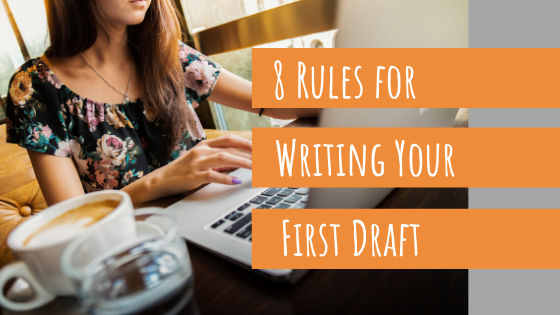Your first draft is a sketch. As author Terry Pratchett said, “It’s just you telling the story to yourself.”
You will have a chance to revise and edit later.
To get the most out of your drafting time, you want to allow your inner five-year-old to emerge. You know, the part of your writing brain that wants to play and jump into mud puddles and have fun!
This is the part of your writing brain that knows so much more than you know you know. It’s your subconscious mind. Your Muse. Your connection to the Divine.
When you pressure your drafting mind to get things right the first time — not to jump in muddy puddles because it’s messy — you may drive her away. Then, writing feels like a slog. A chore. You lose the fun, not to mention your best creative ideas.
Here are my 8 non-negotiable rules for allowing your inner 5-year-old to take the reins so you can finish your first draft faster and in flow.
#1 Set an Intention
Know what you’ll write before you sit down to write it.
I like to use a simple writing planner (a table in a Google Doc) where I write the day’s date, what I plan to write, any notes about my writing session once I’ve finished, and then my plan for my next writing session at the bottom. I can just copy and paste that intention into the “plan” section for the next day.
Presto. The next time you sit down to write, you can get started writing without expending any time or energy deciding what to write.
| DATE | DATE | DATE | DATE | |
| PLAN | ||||
| NOTES | ||||
| NEXT TIME |
# 2 Cut Out Distractions
Set yourself up for success. Close your email. Put your phone in a drawer. Close any tabs that aren’t your outline or your drafting doc. Resist the urge to give in to distractions that feel as if they’re actually responsible things to do, such as research. (More on how to do that in Rule # 5.)
Don’t re-read what you wrote in your last writing session. It will make you want to make changes or additions. Create a bookmark or anchor link (or use an outline with hyperlinked headings) in your draft and link it to the words START HERE at the top of your draft doc. That way, when you open your draft, all you have to do is click and you’ll be in the right place.
#3 Use Your Outline
It may sound obvious, but we often forget to keep our outline handy. Before you know it, you might be lost, meandering into uncharted territory. Your outline keeps you grounded.
As you write, you might come up with great new ideas or head in a slightly different direction. Great! That’s your inner five-year-old at work! Just keep your outline as a reference. It will make sure you stay focused on the goal of the section you’re writing so you don’t lose the power and point of your message.
#4 Move Forward Doing One Task at a Time
It takes energy and time to switch among writing, outlining, brainstorming, revising, and editing. Once you start drafting, keep going! Stick with your intention until you complete it. Then you can re-read if you feel it helps you. If you run out of “road” aka outline, see Rules 6 & 7.
#5 Use Placeholders and Notes to Self
The trick to moving forward and cutting out internal distractions is to use placeholders. Leave a blank or add [brackets] when you don’t know what to write, or when you’re not crazy about a certain word, phrase, line of dialogue, description, etc. Use the first word that comes to mind, then leave a note to yourself to mark the place. This practice is a wonderful defense against perfectionism!
I like to leave digital notes in the margin. (I draft in Google Docs.) Use this same tool to prevent getting distracted by research. You can look up the name of the river in that city later. For now, keep drafting!
#6 Draft the Next Thing You Can
What if you’re drafting along and there’s a piece of information missing that would impact the whole section? You can’t keep writing without either researching or outlining. The answer is to move to a different section. Hop to another spot in your outline. Draft the next thing you can. You have permission to write out of order!
#7 Be an Accordion
When you’re drafting, it’s very natural to run out of road — to reach a place where you realize you need to plan more. Maybe your planning style is only to outline one section at a time. Or maybe you changed some key details as you were drafting, and now your outline needs to be revised to fit the new structure.
Picture yourself as an accordion, moving in and out between big picture planning and detail-driven drafting. Give yourself time to pause and plan more. (This is like the accordion moving out, or like inhaling.) Then, you can come back to drafting. (This is like the accordion moving in, or exhaling.) Just make sure to do your planning and your drafting during different sessions so you can stick to Rule #4.
If there’s no way to prevent a drafting session from morphing into a planning session, that’s OK. You’re still doing the next thing that will help you move forward.
#8 Know When To Walk Away
Writing takes creativity and energy. Sometimes you may find that you simply have no more to give. That’s understandable! Give yourself a break. Walk away. Do something that relaxes you and helps you restore your energy. Forcing yourself to write when you are fatigued is generally not productive. It will take you more time to write fewer words, and they will often sound strained or forced — because they are.
Rules Give You Freedom
These 8 Rough Draft Rules will constrain you enough to give you creative freedom. Your inner 5-year-old can safely play and bring you her best ideas.
This is what makes writing fun! You’re dancing through ideas, never sure of what you’ll write next.
And at the same time, you know you’re heading in the right direction.
Want more help with how to write your first draft without getting lost, feeling uninspired, or procrastinating like it’s going out of style? Grab your copy of Recipe for Drafting: Beat Writer’s Block & Finish the First Draft of Your Novel Faster, available on Amazon.
You’ll find more explanation of these 8 rules, as well as freewriting prompts, tips for writing a great first and last chapter, and step-by-step instructions for crafting your book in flow.

